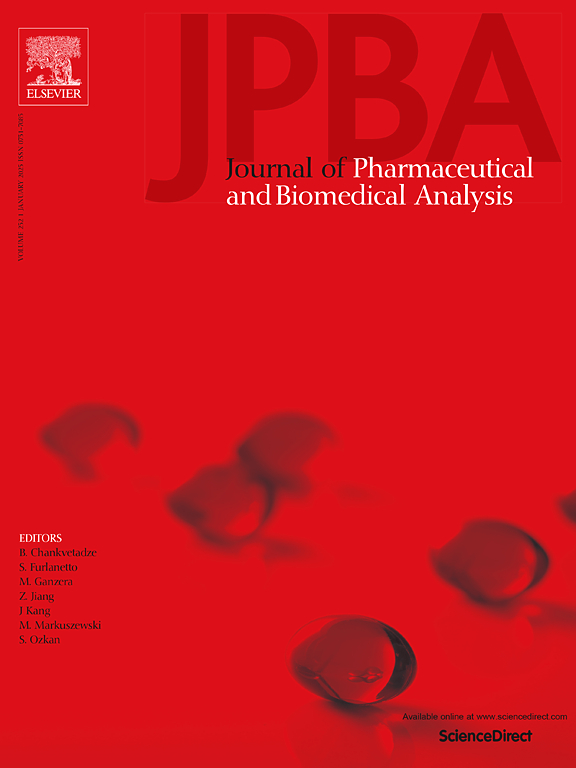用UHPLC-ESI-MS /MS同时评价葡萄提取物中5种黄酮类化合物在大鼠体内的冰山药动学策略
IF 3.1
3区 医学
Q2 CHEMISTRY, ANALYTICAL
Journal of pharmaceutical and biomedical analysis
Pub Date : 2025-04-14
DOI:10.1016/j.jpba.2025.116898
引用次数: 0
摘要
葡萄果实(Viticis fructus, VF)是白荆(Vitex trifolia L.)的干燥成熟果实,含有多种具有良好药理作用的黄酮类化合物。然而,这些类黄酮及其代谢物的药代动力学行为尚不清楚。本研究采用超高效液相色谱-电喷雾串联质谱(UHPLC-ESI-MS /MS)和Iceberg药动学策略综合评价VF中5种黄酮类化合物在大鼠体内的药动学。给大鼠灌胃VF提取物后,大鼠血浆中仅检出少量游离牡荆卡素、黄脾醇D和木犀草素,而游离槲皮素和山奈酚的含量均低于相应的定量下限。相比之下,用β-葡萄糖苷酶水解发现了大量的槲皮素、山奈酚、牡荆卡素、黄脾醇D和木犀草素。酶解后总叶黄素、黄脾醇D和木草素从时间0到最后可测浓度的最大血浆浓度(Cmax)和曲线下面积(AUC0-t)值均显著高于酶解前的游离值(P <; 0.05)。这些结果表明,大部分VF类黄酮主要以II期代谢物存在于大鼠血浆中,通过肠肝循环等途径延长其在体内的停留时间。这些浓度较高的II期代谢物可能是其药理作用的重要物质基础。本文章由计算机程序翻译,如有差异,请以英文原文为准。
Iceberg pharmacokinetic strategy for simultaneous evaluation of five flavonoids from Viticis fructus extract in rats using UHPLC–ESI–MS/MS
Viticis fructus (VF) is the dry and ripe fruit of Vitex trifolia L. var. simplicifolia Cham or Vitex trifolia L., which contains several flavonoids exhibiting promising pharmacological effects. However, the pharmacokinetic behaviors of these flavonoids and their metabolites remain unclear. This study aimed to comprehensively evaluate the pharmacokinetics of five flavonoids from VF in rats using ultra-high-performance liquid chromatography coupled with electrospray ionization tandem mass spectrometry (UHPLC–ESI–MS/MS) and the Iceberg pharmacokinetic strategy. After gavage administration of VF extract to rats, only small amounts of free vitexicarpin, chrysosplenol D and luteolin were detected in rat plasma, while the contents of free quercetin and kaempferol were both lower than their corresponding lower limits of quantification. In contrast, enzymatic hydrolysis with β-glucosidase revealed significant amounts of quercetin, kaempferol, vitexicarpin, chrysosplenol D, and luteolin. The maximum plasma concentration (Cmax) and the area under the curve from time zero to the last measurable concentration (AUC0–t) values of total vitexicarpin, chrysosplenol D and luteolin after enzymatic hydrolysis were all significantly higher than those free values before enzymatic hydrolysis, respectively (P < 0.05). These findings indicate that most flavonoids from VF primarily exist as phase II metabolites in rat plasma, which can prolong their residence time in the body through intestinal hepatic circulation and other pathways. These phase II metabolites with higher concentrations may be an essential material basis for their pharmacological effects.
求助全文
通过发布文献求助,成功后即可免费获取论文全文。
去求助
来源期刊
CiteScore
6.70
自引率
5.90%
发文量
588
审稿时长
37 days
期刊介绍:
This journal is an international medium directed towards the needs of academic, clinical, government and industrial analysis by publishing original research reports and critical reviews on pharmaceutical and biomedical analysis. It covers the interdisciplinary aspects of analysis in the pharmaceutical, biomedical and clinical sciences, including developments in analytical methodology, instrumentation, computation and interpretation. Submissions on novel applications focusing on drug purity and stability studies, pharmacokinetics, therapeutic monitoring, metabolic profiling; drug-related aspects of analytical biochemistry and forensic toxicology; quality assurance in the pharmaceutical industry are also welcome.
Studies from areas of well established and poorly selective methods, such as UV-VIS spectrophotometry (including derivative and multi-wavelength measurements), basic electroanalytical (potentiometric, polarographic and voltammetric) methods, fluorimetry, flow-injection analysis, etc. are accepted for publication in exceptional cases only, if a unique and substantial advantage over presently known systems is demonstrated. The same applies to the assay of simple drug formulations by any kind of methods and the determination of drugs in biological samples based merely on spiked samples. Drug purity/stability studies should contain information on the structure elucidation of the impurities/degradants.

 求助内容:
求助内容: 应助结果提醒方式:
应助结果提醒方式:


